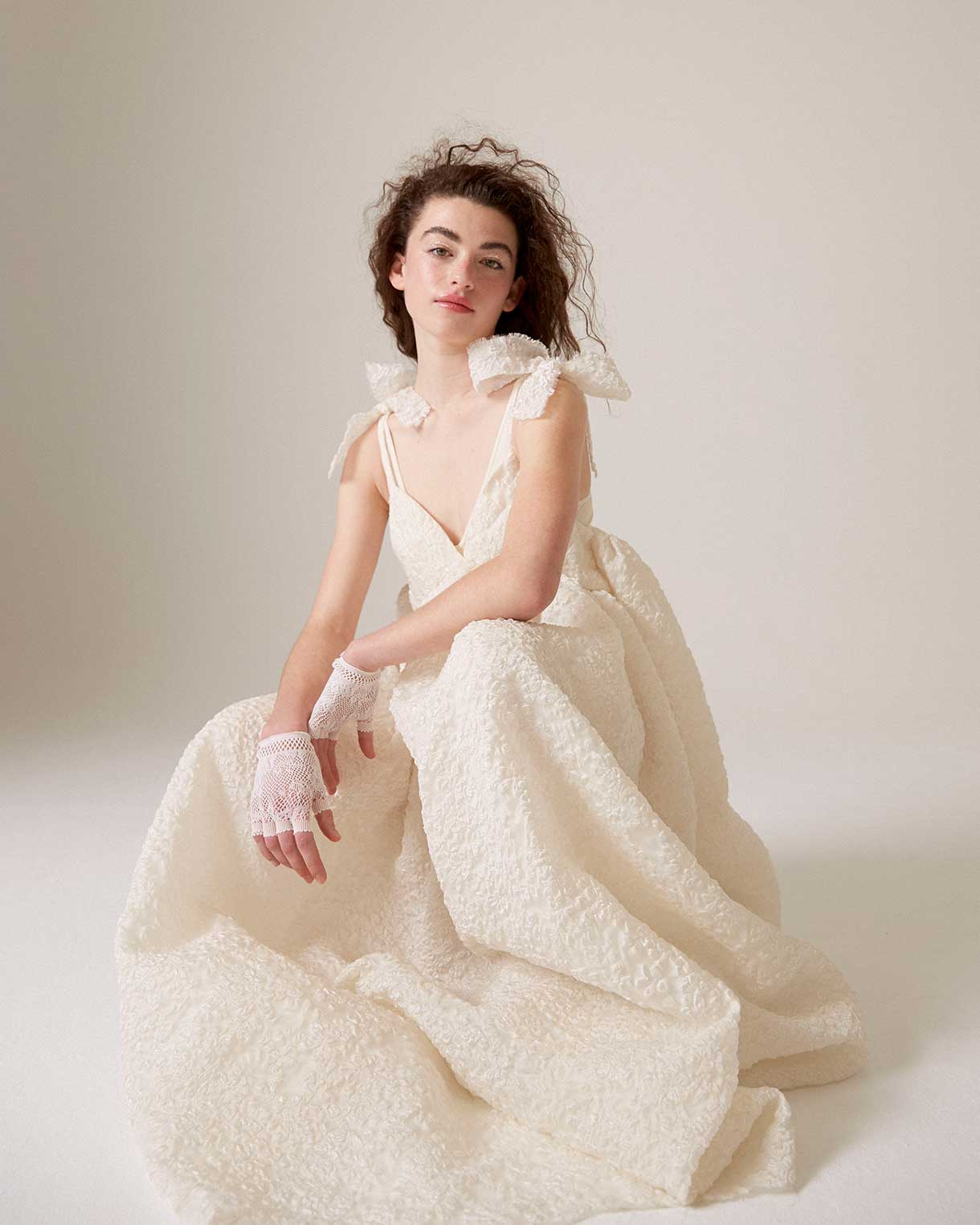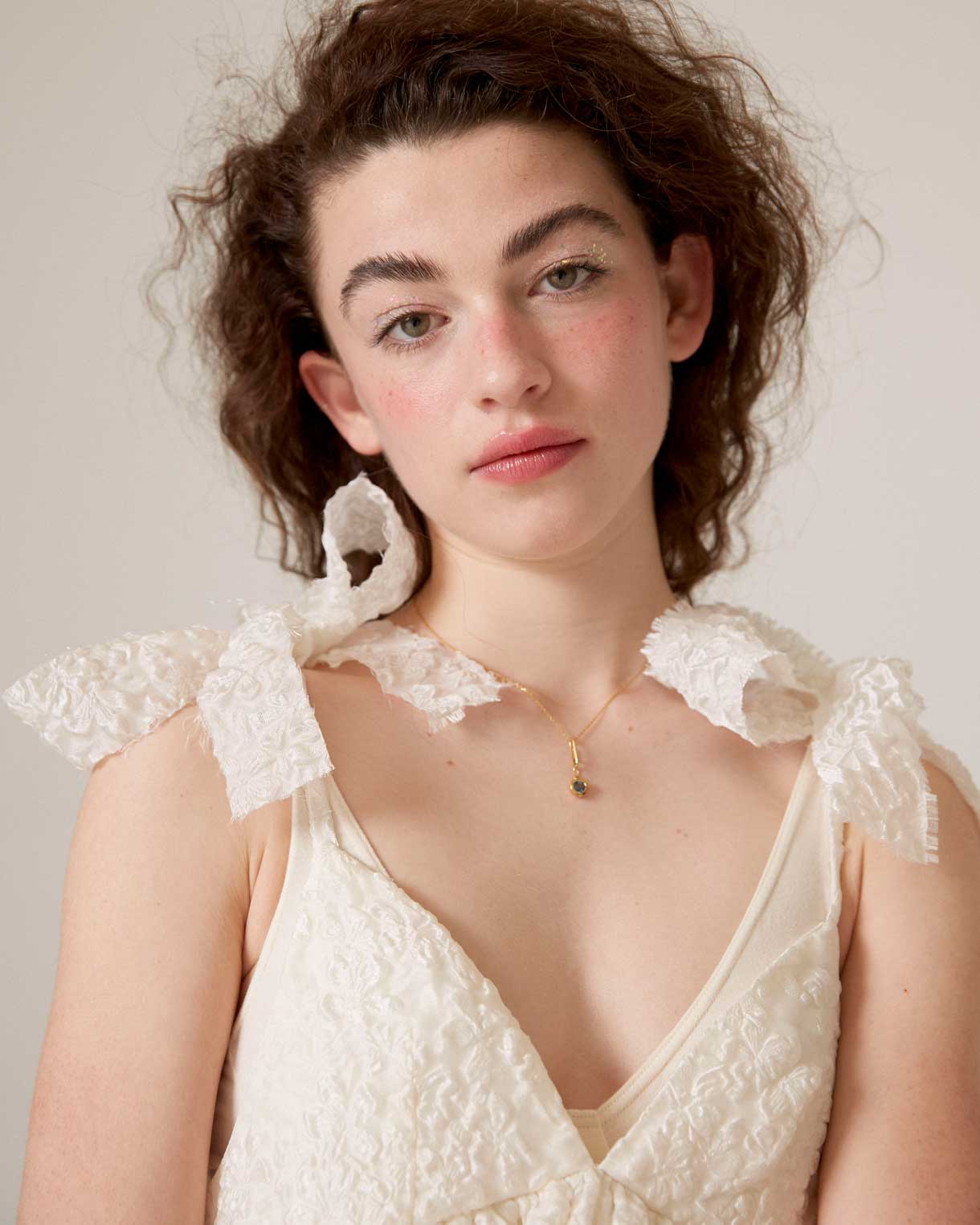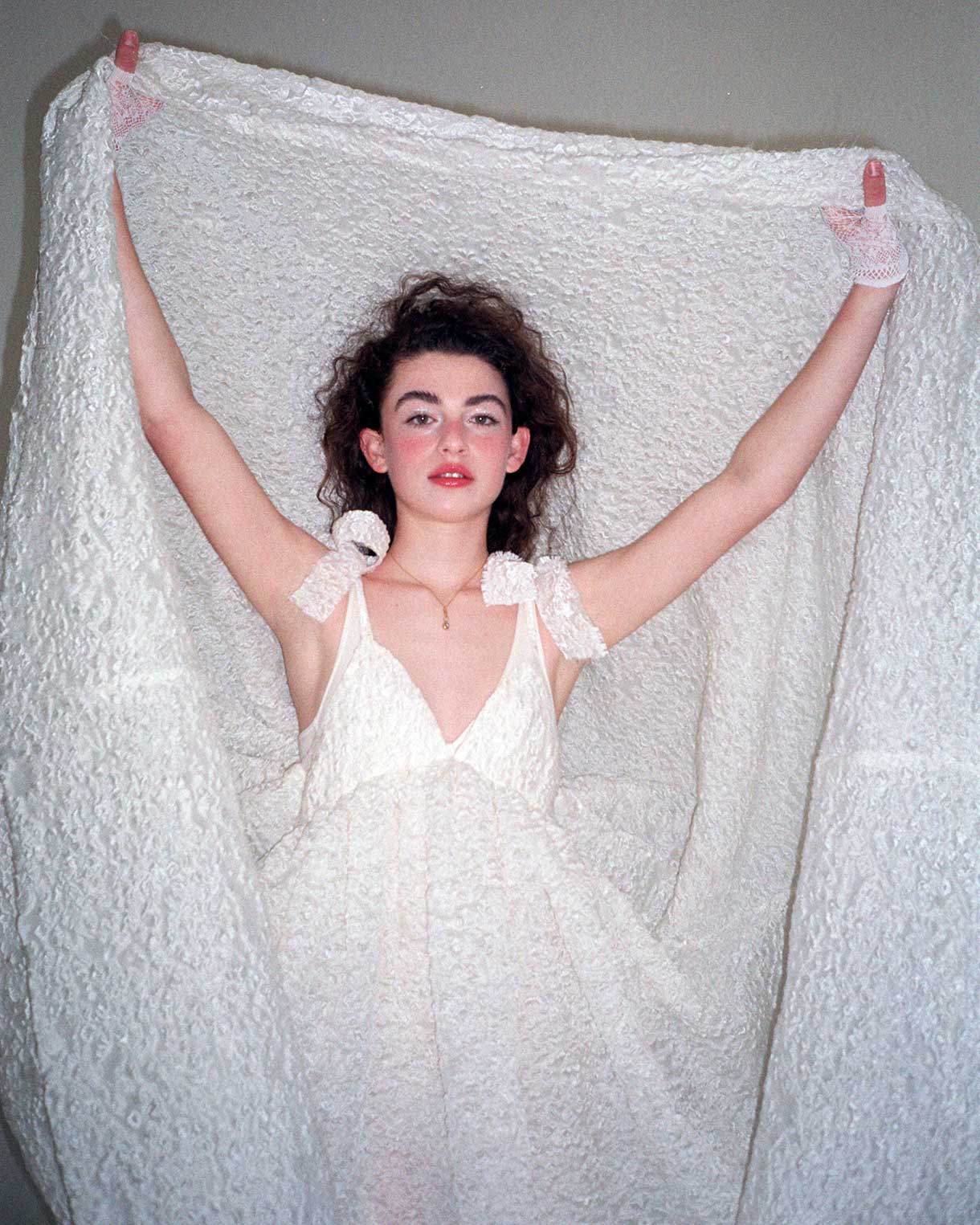(Español) Los cuadros Vichy: del campo a la pasarela
‘Cinema and Fashion’ by Jean Paul Gaultier
 El diseñador de moda y director artístico de la muestra, Jean Paul Gaultier, en CaixaForum Barcelona.
El diseñador de moda y director artístico de la muestra, Jean Paul Gaultier, en CaixaForum Barcelona.
Jean Paul Gaultier is the enfant terrible of fashion in his own right. Although he is no longer creatively spearheading his namesake brand, now spearheaded by his successor Olivier Rousteing, Gaultier will always be Gaultier. A self taught genius. Transgressive and irreverent, but from his kind facet. A free verse of fashion that he revolutionized in the 70s, 80s and 90s exalting difference, celebrating diversity, breaking stereotypes and exploring the beauty of the margins. Gaultier was not interested in the classic or the conventional, but he did investigate how he could empower the women of his time through clothing. His designs were the perfect armor for a new generation that wanted to express their strength, dynamism and freedom through clothing. One of Gaultier’s icons, the pointed corset worn by Madonna on the ‘Blonde Ambition’ world tour in 1990 was created thanks to the influence exerted by the woman who has most inspired him: his grandmother and her extensive lingerie wardrobe reminiscent of the enfant terrible from his childhood.
This iconic garment, among others, can be seen live in the new exhibition premiered at CaixaForum Barcelona: ‘Cine y moda. Por Jean Paul Gaultier’. An exhibition co-organized by the La Caixa Foundation and La Cinémathèque francaise that proposes an eclectic journey that intertwines cinema and fashion with great creators and artists, from the personal point of view of the controversial creator, as a costume designer and as a movie buff. For Gaultier there is no cinema without fashion, and vice versa.

Backstage, desfile de Jean Paul Gaultier, colección Barbès, 1984, prêt-à-porter de mujer otoño-invierno 1984-1985. © William Klein.
Divided into five areas, the author’s exhibition where Gaultier captures his gaze, reviews the presence of the world of fashion in cinema, the collaborations of great designers in film costumes and the creation of male and female archetypes. The enfant terrible of fashion emphasizes key aspects that are present in his career as a designer such as female empowerment and pays attention to heterodox figures of male and female warriors, androgynous and transvestites, as well as the influence of rock, punk and and queer that have marked fashion so much in recent years.
After passing through Paris and Madrid, the exhibition, dedicated to the memory of the filmmaker Tonie Marshall, brings together in Barcelona a heterogeneous set of more than 100 pieces of clothing that are shown in nearly 70 looks, fragments of more than 90 films and 125 graphic representations (posters, sketches, frames and photographs), between originals and reproductions, mostly from the prestigious collection of La Cinémathèque Française and complemented by works from more than twenty national and international lenders.

Díptico Marlene Dietrich. Masque & Narcisse, 2021. © Bastien Pourtout i Edouard Taufenbach, colección Pierre Passebon, 2021.
Among the nearly 70 iconic film looks are dresses worn by Grace Jones in ‘A View to a Kill’ (1985), Catherine Deneuve in ‘8 Women’ (2002), Grace Kelly in ‘Rear Window’ (1954); Sharon Stone in ‘Basic Instinct’ (1992); Marilyn Monroe in ‘Nude Eve’ (1950); ‘Tay Garnett’s Seven Sinners (1940); Brad Davies in ‘Querelle’ (1982) or as we said at the beginning, the famous pink corset that graced Madonna on her world tour.
Also, the ‘Superman’ suits (which Christopher Reeve wore); ‘The Mask of Zorro’ (1998), with Antonio Banderas; the shorts that Sylvester Stallone wore in ‘Rocky’, or Victoria Abril’s wardrobe in ‘Kika’ (1993) which, together with that of other films such as ‘Bad Education’ (2004) or ‘The Fifth Element’ (1997) , was designed by Gaultier. In this line, haute couture designs by Coco Chanel, Pierre Cardin, Hubert de Givenchy, Manuel Pertegaz, Balenciaga and Sybilla, among others, are also on display.

Fotografía entre bastidores de la película ¿Quién eres tú, Polly Maggoo? 1966 © William Klein/ Films Paris New York.
Two films that mark the beginnings of Gaultier
Among all the parade of looks, projections and key garments, there are two films that take pride of place in the exhibition and have to do with the origins of the designer. The first would change the course of his life. Gaultier was then 13 years old when he first saw Jacques Becker’s ‘Falbalas’ (1945). A melodrama starring a seamstress and set in the hustle and bustle of a sewing house during the postwar period. This film is the “culprit” of his desire to dedicate himself to the world of fashion. From there he began to design figurines that he would later transform into designs. The other film that has marked the French creator has been ‘Who are you, Polly Maggoo?’ (1996) by William Klein, who in the film analyzes his time with a keen eye and lays bare the then incipient reality shows. It is a satire of the egocentric delusions of the world of haute couture, where at that time the space age dominated and everyone from the misanthropic couturier to the most versatile editor-in-chief fell.

Pedro Almodóvar, Victoria Abril y Jean Paul Gaultier en el plató de Kika, 1994 © Nacho Pinedo.
Moda y arte, actividades en paralelo
The exhibition ‘Cinema and fashion. By Jean Paul Gaultier’ will be open to the public until October 23. On this occasion, to investigate the close relationship between fashion and art, CaixaForum Barcelona has organized a cycle of conferences in September that proposes dialogues on how art and fashion influence each other: is art the source of inspiration for fashion or are fashion codes the ways the artist chooses to develop his poetics? The French philosopher and sociologist Gilles Lipovetsky, the architect Manuel Blanco, the journalists Isabel Margalejo and Carlos Primo, the popularizer Charo Mora (responsible for the cycle) or the model Sita Abellán, are some of the names that will illustrate the links between fashion and art, architecture, literature and music.




Detalles de la exposición ‘Cine y moda. Por Jean Paul Gaultier’
(Español) De Schiaparelli a Valentino, el fucsia está de moda en 2022
With their own shine! The sequins of yesterday and today
 The summer season begins with a trend less and less reserved for special occasions: sequins, which with their glitter catch all eyes. Disconnected from their comfort zone, these small metallic sheets sewn into the fabric become the protagonists of the moment together with other materials that dazzle on their own, such as iridescence or satin finishes that produce a more discreet shine.
The summer season begins with a trend less and less reserved for special occasions: sequins, which with their glitter catch all eyes. Disconnected from their comfort zone, these small metallic sheets sewn into the fabric become the protagonists of the moment together with other materials that dazzle on their own, such as iridescence or satin finishes that produce a more discreet shine.
On this occasion, sequins, along with fluorescent colours and transparencies, have featured on the fashion shows of the SS22 collections of Tom Ford, Michael Kors, Loewe, Valentino or Rodarte and are set to invade the street through resplendent outfits. The key to sequins, until now reserved for specific celebrations such as New Year’s Eve, is that there are many options to show them off successfully in garments to wear at all hours. Day and night without paying attention to brightness or excesses. From the rock & roll looks of Saint Laurent, to the sophistication of Chanel and Celine that combine them with tweed or in key details such as Gucci, Balmain or Paco Rabanne, creator of the iconic metallic mesh.

From Tutankhamun to Leonardo da Vinci
The origin of sequins dates back to Ancient Egypt, where small gold and silver discs were sewn onto the clothes of the pharaohs and their consorts as a sign of wealth. In fact, it was during the discovery of Tutankhamun’s tomb in 1922 that archaeologists found, among other objects, clothing decorated with shiny metal disks. A time that coincided, in turn, with the metallic fever of the Roaring 20s, embodied by the costumes of the flappers and the Egyptomania that unleashed this fact, which inspired the designers of the time to design outfits with metallic discs to stand out on the dance floor.
In English, the word sequin (sequin, is linked to the Arabic term sikka (coin) and al zecchino, a golden coin minted in Venice during the 13th century. The first sequins were coins sewn onto clothing, for reasons ranging from displaying wealth and status to making life difficult for thieves. It is also said that Leonardo da Vinci, one of humanity’s great inventors, devised a machine to produce small metal discs. A prototype that was never manufactured, but that already establishes the age of the sequin.
Later, in the 17th and 18th centuries, wallets and cases began to be used, and pockets appeared. Therefore, in men’s and women’s clothing it was no longer necessary to sew the coins to the clothes to keep them safe, and the small metal disks became a purely aesthetic ornament.

The sequin shines in the 20th century
Sequins as we know them emerged in the 20th century. Its sparkles began to adorn the rich dresses of the Belle Époque, added touches of light to the creations of the 1920s and returned to adorn the garments of the sensual 1950s. Actresses like Marilyn Monroe or Rita Hayworth succumbed to the sparkle of sequins with innumerable outfits that shimmered on and off the celluloid. A sparkly dress from the era that connects with today is the iconic beige dress that the blonde diva wore when she sang ‘Happy Birthday’ to President John F. Kennedy in 1962. That same crystal-covered gown was worn by Kim Kardashian in the Met Gala 2022.
The materials used to create the sequins also changed over time. The metal of the first prototypes evolved into gelatin in the 1930s. The latter material was lighter, but it was brittle and did not withstand changes in temperature well. Later, they became plastic, flexible and resistant to washing. Thanks to this change, sequins became more practical, less expensive and more affordable than their previous versions.
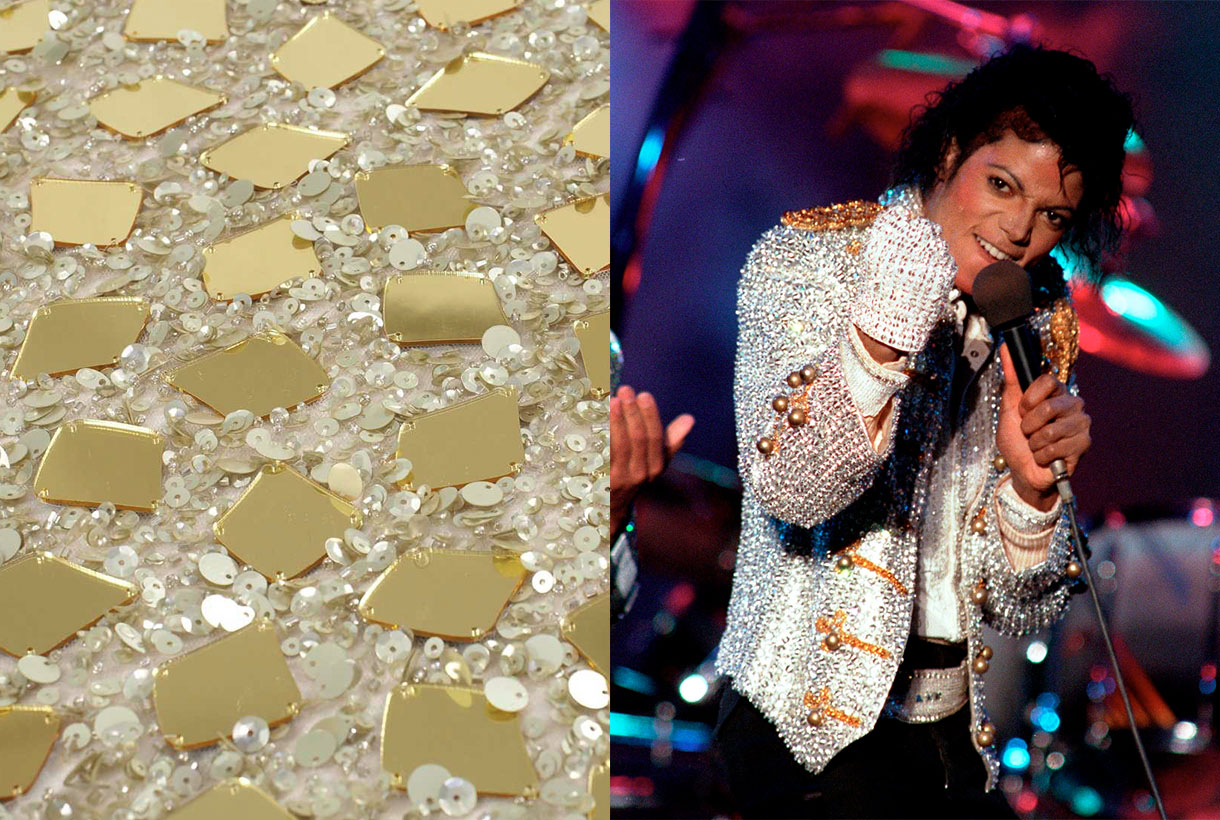
An ornament linked to music, movement and excess
With the innovation of new materials and the triumph of prêt-à-porter in the sixties, the use of sequins became popular in more common clothing that became daring, lively and colourful. The objective? Adorn the silhouette, empower it and become the center of attention. This manifested very well in the seventies with disco fever. In the countercultural movements, sequins and all shiny fabrics became a symbol of rebellion against the system they considered serious and boring. That’s when the glam rock era began . A sensual, androgynous, eccentric and revolutionary movement whose symbol was David Bowie with his iconic alter ego: Ziggy stardust . The man with the stars, and other singers of the time, wrapped themselves in lamé suits, sequins and lots of glitter.
Shiny fabrics, with sequins being the favourite, shone again in the 1980s. Michael Jackson was responsible for bringing glitter and pharaonic garments back to life with memorable performances where the King of Pop donned suits covered in sequins and rhinestones.

Nowadays, sequins, as well as other shiny fabrics, are subjected to the ups and downs of cyclical fashion. Its material is still based on plastic, now mostly recycled, but with special coatings. What has not changed is its meaning. Sequins spark the imagination, become visible and illuminate people’s daily lives. They are an element of escapism, something to cling to other fantasy worlds. And we already know that fashion is a dream and at Gratacós we like to make you dream through our sequin fabrics. Here we leave you a selection of the most innovative so that you shine with your own light.




Orange, the colour of uniqueness
 Orange is a more common colour than we think, although its role in history has always been relegated to the background. This hybrid shade between red and yellow provokes an immediate reaction when recognized. It activates, stimulates, surprises and entertains. Not surprisingly, this striking colour is always associated with the unconventional. Its uniqueness has played an important role in art, history and design. Since ancient times orange was present in Ancient Egyptian rituals, it has been considered a sacred colour in various Asian cultures and has come to fall in love with artists such as Vincent van Gogh and Toulouse-Lautrec who used orange in their paintings. We reveal some anecdotes about this exotic colour, often underestimated.
Orange is a more common colour than we think, although its role in history has always been relegated to the background. This hybrid shade between red and yellow provokes an immediate reaction when recognized. It activates, stimulates, surprises and entertains. Not surprisingly, this striking colour is always associated with the unconventional. Its uniqueness has played an important role in art, history and design. Since ancient times orange was present in Ancient Egyptian rituals, it has been considered a sacred colour in various Asian cultures and has come to fall in love with artists such as Vincent van Gogh and Toulouse-Lautrec who used orange in their paintings. We reveal some anecdotes about this exotic colour, often underestimated.

Orange in ancient times
The ancient Egyptians were the first to use a shade between yellow and orange that they extracted from the mineral realgar to decorate their tombs. The pigment that was extracted was toxic – it contains arsenic – and was used by the Chinese to drive away snakes, as well as being used in the country ‘s traditional medicine . Another related mineral, orpiment was also used as a pigment and was considered a highly valued trade commodity in ancient Rome. In the Middle Ages the orange pigment was used during the Middle Ages in manuscripts.
In Asia, orange was considered a symbol with different interpretations depending on the culture of each country. This tonality is present in many of the Asian religions. In Buddhism, orange is a sacred colour: it is considered the tone of enlightenment and the search for knowledge and for this reason, the clothing of Buddhist monks is traditionally of this colour. For Confucianism, orange symbolizes the colour of transformation. In Hinduism, the dress worn by Krishna – one of the most revered personified deities – is always in this brilliant hue. The name of the colour in India and China derives from saffron which in turn was the most expensive dye in the two countries. These Asian powers considered that orange represented the perfect balance between the perfection of yellow and the power of red.

A nameless colour
In Asia, orange was a revered hue. On the other hand, in Europe the colour did not have a name until the 16th century when Portuguese merchants brought from India and China the most exotic fruits of the time: oranges and tangerines, tinged with a colour that Europeans called reddish yellow until then. This striking colour imported from the Far East via orange trees was named after the fruit itself. Orange in Spanish, orange in english, arancia in italian and orange in Portuguese.
Another curiosity: today orange is a colour that connects on a psychological level with the world of flavours and is pleasing to the eye when linked to food. Peaches, apricots, mangoes, carrots, prawns, prawns, salmon, pumpkins, curries… Orange can be an appetizing colour, right?

Orange in art
In Western European art, the use of orange became common as from the 19th century, when the first synthetic orange pigment called chrome orange was produced. This tone was a favourite of Pre-Raphaelite and Impressionist painters, who made use of colour to capture the effects of natural light. Artists such as Monet, Gauguin, Renoir, and Toulouse-Lautrec used colour extensively to elicit feelings of warmth, escapism, and playfulness. If there is an artist who was directly linked to the colour orange, it was Vincent van Gogh, who through painting mixed his own shades of orange and used them in contrast to the blues and purples characteristic of his work.

A seasonal colour in 2022
Although Pantone crowned Very Peri lilac as the colour of the year in 2022, the truth is that the fashion industry seems to have set its sights on a more intense and vital hue to lift the spirits. On catwalks through the summer and pre-fall collections , on the street style of fashion weeks , in the windows of the big firms… orange has emerged as one of the star shades of the season in all its possible ranges.
Orange has been present in the current SS22 collection by Christian Siriano, Collina Strada or Proenza Schouler, transmitting optimism and joy to the clothes presented, but it is in the transition collections that it gains more strength. For example, Erdem is one of the firms that has opted for this colour, but in its softer versions such as boiler orange for satin dresses with black motifs and looks that play with textures and use the same tone. For its part, Chloé has opted for pastel shades giving it a less aggressive look. Oscar de la Renta has given orange reddish nuances, always accompanied by other colours or in bag format. Instead, Gucci has opted this season for a vitamin orange that dyes a multi-layered skirt in the same tone.

The namarillo is once again stepping strongly on the catwalks. A hybrid shade halfway between orange and yellow that became popular in 2016 among the spring collections and caused a furor due to its showiness and luminosity, being the summer shade at the time. Now Prabal Gurung has recovered this vitamin tone and has incorporated it into a large part of the looks of its latest collection. In a slightly more subdued tone, Staud has turned it into knitted sets with microshorts and Chanel into jumpsuits that are the hallmark of its creative director, Virginie Viard .

How to combine it?
Sometimes what is seen on the catwalk does not necessarily end up being worn on the street. And orange seduces at first sight, but it is not an easy colour to wear nor is it discreet. Still, the street style of the fashion prescribers or the looks exposed by the celebrities in the network carpets are the best reference to demonstrate the chromatic possibilities that orange has in the wardrobe.

The easiest way to get started in the colour orange is to do it in small doses through a single garment or simply relegating it to accessories. The tones that always go well with orange are the neutral ones: white, black and beige tones or makeup that creates a base effect. On the other hand, if your level of daring is high, orange looks great in a total look through dresses, jacket suits or combinations of tops with skirts. As for risky combinations that enhance this vitamin colour, there are some that are often repeated on the catwalk that flow due to their contrast: orange with fuchsia for maximum daring; orange with intense green to play with the complementary ones; orange with light blue or pale pink to reduce intensity; orange with purple to claim prominence; orange with gray for rainy days, or obviously, orange with orange for a harmonic visual game. This colour accepts more shades than you would have imagined!
Finally, we show you some of our most vitamin-rich fabrics for the new season. What do you imagine designing with them?




(Español) Vuelve el festival Moritz Feed Dog en Barcelona
Gratacós at Barcelona Bridal Week 2022
 The Barcelona Bridal Week 2022 has closed the calendar of catwalk shows in the Catalan capital. The international bridal fashion fair, which was held from April 20th to 24th at the Fira de Barcelona, has opted for a return to normality with face-to-face fashion shows of 34 designers aimed at professionals and future brides. It also had a large exhibition space in which 320 brands linked to the bridal and festive sector have participated.
The Barcelona Bridal Week 2022 has closed the calendar of catwalk shows in the Catalan capital. The international bridal fashion fair, which was held from April 20th to 24th at the Fira de Barcelona, has opted for a return to normality with face-to-face fashion shows of 34 designers aimed at professionals and future brides. It also had a large exhibition space in which 320 brands linked to the bridal and festive sector have participated.
Gratacós did not want to miss the opportunity to once again watch the live fashion shows of the bridal designers who use our fabrics in the preparation of the new season collections. That is why we have been attentive to each look presented because we are amazed to see once again how our fabrics are transformed into sophisticated bridal designs. Here we share with you some of the most special bridal looks of the 2023 season.

Higar Novias
The Sevillian family business Higar Novias, founded in 1980, presented the ‘Origen’ collection, based on the dialogue between sewing and architecture. The new proposal is developed based on the most emblematic patterns, merging them with pure and current lines of contemporary architecture. If we focus on detail, throughout the collection the wide variety of sophisticated, feminine and contemporary designs can be appreciated. Enriched fabrics and single-colour jacquards predominate, coexisting in harmony with silhouettes and semi-transparent bodies, adorned with feathers, on fabrics rich in beading, which combine with wide tulle skirts and small shiny details.
On the other hand, the party collection combines the versatility of urban fashion and the elegance that characterizes Higar Novias designs so much. Maxi prints and embroidery are combined with a palette of bright colours in dresses fitted at the waist that take on volume in the skirts. Also to be highlighted are the rhinestones on low-cut bodies and very feminine mermaid silhouettes, which invite you to love fashion for special occasions.

Isabel Sanchis
Isabel Sanchis new collection is inspired by the cultural diversity that characterizes her clients from all over the world, as well as her way of understanding fashion. As a result, the Valencian designer has created pieces that are based on a worked prêt-à-porter, from geometric prints close to op art to sewing pieces with volumes and meticulously made handicrafts, which are part of the essence of the firm. Isabel Sanchis wanted to show the best of the brand, highlighting the craftsmanship and precision of detail. As for the colour palette of the new collection, in addition to black, always present in the Isabel Sanchis collections, a range of browns, oranges, pistachios and pinks have been introduced that bring optimism and passion for living.

Lorena Panea
Lorena Panea is an atelier and women’s brand that pays homage to the designs of Antiquity, creating exclusive and timeless bridal fashion for contemporary women. The young designer presented the ‘Anatolia’ collection on this occasion. A set of six boho-style wedding dresses, inspired by the ancient goddesses of Mesopotamia, Egypt and Asia Minor. The designs collect ethnic and nomadic influences from those caravans that travelled across the continents spreading ancestral beliefs and merging the cults of ancient deities. Each design is made up of worked fabrics such as lace, embroidered tulle and striking ornaments.

Nicolás Montenegro
Nicolás Montenegro recalls the testimony of the first interview he had with Rossy de Palma, muse and friend of the brand. Thus, ‘Savoir Fair’ is a precious and meticulous collection that is created based on the demand of clients who demand elaborate, different sewing and made with a selective sartorial pattern. The proposal is articulated through rich fabrics, such as silk tulle, Italian brocades and beading with embroidery made by hand on a frame, following Andalusian artisan techniques. Nicolás Montenegro’s girlfriend is undoubtedly a diva who feels unique and sure of herself.

Olga Macià
Olga Macià she is one of the revelation designers of bridal and party fashion. The creator who trained at the Felicidad Duce Higher School of Design and Fashion (FELI) hid the winning card at a wedding fair up her sleeve: the ‘Ace of Hearts’. This is the name of the new 2023 bridal proposal and festive collection that revolves around the symbolism of love. The proposal did not lack risky transparencies, vertiginous necklines, short designs with lengths and two-piece suits that merge with party dresses in energetic colours and bright tones. The fabrics are fantasy textures, flowers, transparencies, coloured sequins and impact nets.

YolanCris
Yolancris, the Spanish brand of design and craftsmanship of party and wedding dresses from the sisters Yolanda and Cristina Pérez, surprised once again at Bridal Week with its revolutionary designs that are born from the excellence of artisanal haute couture, accommodating every type and style of women. In diversity and in breaking with conventional bridal clichés, the firm finds a way to pay tribute to each woman by exalting her own personality. In the ‘Touch’ line, Yolancris extolled resilience, born during the pandemic, through anti-bride proposals that represented a new generation of brides with very particular tastes and needs. On the contrary, ‘Origins’ took up the essence of Yolancris, recovering the boho style for brides. Now, the ‘She’ collection continues with the values of Touch and Origins, but with a firm commitment that highlights the individuality and authenticity of each bride. A symphony of three styles: bohemian, anti-bride and haute couture in richer and more complex designs that adapt, better than ever, to the essence of each woman.

The new generations of bridal design
And who are the bridal designers of the future? IED Barcelona it is one of the best design quarries, a launch pad for young talents who graduate annually and await their first opportunity to enter the world of fashion. This year, the school renewed synergies with the Barcelona Bridal Fashion Week and was present at the world fair with a textile flower workshop that values sustainable design through the use of recovered haute couture fabrics. A raw material that Gratacós gave so that the students could recreate their designs. This event also served to celebrate a new edition of the Scolarship for Talent by Gratacós awards. On this occasion, the first prize went to Myriam Medina, a student on the Postgraduate Course in Wedding and Ceremony Dress Design, for the ‘Allegra’ model from the La Toscana collection, Siena. A proposal inspired by this region of central Italy that will be the star of the next showcase in May. Do not miss the opportunity to see the dress live in our space in Barcelona.


The Gratacós fabrics at 080 Barcelona Fashion. SS22 collections
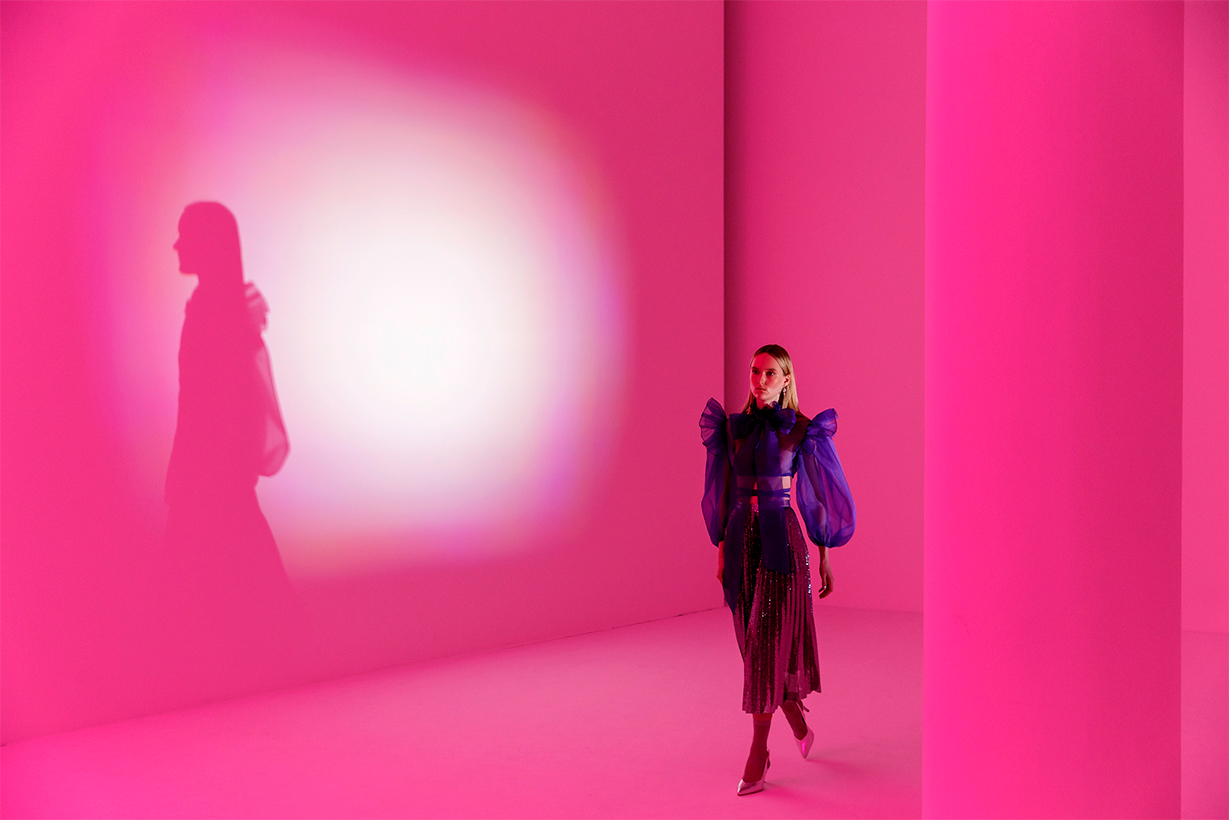 April is the month of fashion in Barcelona. Prior to a new edition of Barcelona Bridal Fashion Week, a week ago saw the start of the latest edition of 080 Barcelona Fashion, with 22 virtual parade shows and designers who presented the new season in the Macba, within the rationalist building designed by the architect Richard Meier. A new staging of the imaginative creativity exhibited by brands via Fashion Films, seasonal collections that can be followed visually on the website of the Catalan catwalk. Gratacós has also followed the latest fashion trends to check once again how our fabrics have taken shape thanks to the designers who habitually trust in us: Avellaneda, Eiko Ai, Menchen Tomás, Yolancris and Victor Von Schwarz. We review the new creations and some of the key looks.
April is the month of fashion in Barcelona. Prior to a new edition of Barcelona Bridal Fashion Week, a week ago saw the start of the latest edition of 080 Barcelona Fashion, with 22 virtual parade shows and designers who presented the new season in the Macba, within the rationalist building designed by the architect Richard Meier. A new staging of the imaginative creativity exhibited by brands via Fashion Films, seasonal collections that can be followed visually on the website of the Catalan catwalk. Gratacós has also followed the latest fashion trends to check once again how our fabrics have taken shape thanks to the designers who habitually trust in us: Avellaneda, Eiko Ai, Menchen Tomás, Yolancris and Victor Von Schwarz. We review the new creations and some of the key looks.

Summer nights
Faithful to his hedonist philosophy the dandy Juan Avellaneda transposes us to tropical latitudes in his new summer collection to continue exploring the most relaxed elegance, inspired by warm paradises in the north of Africa. The central feature of the creation is via natural fabrics, luminous or fiery shades such as pink, orange and coral, and patterns that in general lack rigidity. There are also several models of jacket, the fetish garment of the brand of this Barcelona designer, which oscillate effortlessly between male and female wardrobes. The prints move away from the banal to embrace a Mediterranean version of delicateness that gives character to ethereal skirts and smoking-jackets which rebel against the boring. The garments evoke the practical elegance of Saharan and classic tailoring by those mid-century holiday-makers who immortalized Slim Aarons. Blouses caress the body and intertwine. Trousers dance and dresses cling to the skin or deploy fabulous volumes and flyers, another 100% Avellaneda detail. In Au réveil il était midi all the clothes combine with everything, they harmonize and flow for a perfect summer.

The warm sunlight
Eiko Ai dazzles us with Lucid Dreams, a radiant collection inspired by the vitality of solar energy. In addition to this inspiration Glò Lladó’s formula remains firm in each of her designs and consists of promoting feminine beauty by playing with delicacy and sensuality. And how does she achieve it? Via vaporous silhouettes, ethereal fabrics which give glimpses of skin and via evocative stamping that mixes sophistication without abandoning the casual and cosmopolitan spirit of this Barcelona company. The new summer creation from Eiko Ai enhances the kimono dresses, fluid blouses and two-piece combinations featuring transparencies, subtle glitter and faded prints with other florals that pay tribute to that mystical vision of woman as an urban nymph. The palette of the collection goes for positivism, summer life and golden light via intense oranges playing with the range of yellows, pinks and whites and brushstrokes of intense blue sky.

Class is class
For his part, Menchen Tomás reminds us of the importance of inheritance in Old Money, a collection that is inspired by the way of dressing and living of American families who have managed to pass fortune, class and status from generation to generation. An aesthetics characterized by sophistication, the fusion between the classic and the contemporary and timeless elegance, far from the culture of logo and ostentation. With that interpretation the Barcelona company brings together garments such as dresses and midi-skirts, pinned wide trousers, voluminous poplin shirts with other sporty garments that could be used for a day in a country-club or dinner in a garden on a summer night. Regards fabric details there is no shortage of silks, organzas and tulle flowers in a vibrant chromatic palette: blue, lime green, yellow, fuchsia-pink and bright-red.

Fashion without gender
Victor von Schwarz is part of the new generation of young talents that bring creativity and freshness on the 080catwalk. This time, the designer Barcelona presented a collection inspired by the Asian Mafia films of the 80s and 90s, whose centre of operations was the red neighbourhoods of cities such as Taipei or Hong Kong. Victor von Schwarz is committed to fashion without gender. Therefore, the designer, inspired by oriental clothing, creates open pieces, which anyone can wear, regardless of sex or gender. The silhouettes of the new summer creational are divided into two blocks. The first is very bright, with volumes, drape and transparency features that give a glimpse of skin. The second, part of a much more square silhouette and with variations of the classic tailored jacket. In this collection the fabrics are characterized by their imaginativeness. Sequins are prominent, from Vichy print to bright degrade. We also highlight bright laminates based on viscose and tulles with silver prints. As for colours, pastel shadestones and splashes of colour are a feature of this genderless creation.

Black velvet
Yolancris this time participated in the 080 Barcelona Fashion with her party collection, leaving aside her more experimental project Y Como. The new creation highlights the craft-work redolent of her own workshop itself where the accent is on velvet, flesh-colour and black. With regard to detail, velvet is mixed with golden threads, embedded French lace and macramés in an attractive combination. Binomies of colour also dominate: gold-black and white-black, and are separated with explosions of monocoloured dresses: red and powder pink. As for silhouettes, the collection brings together some classic pattern ideas combined with some more daring features, evident, for example, in the openings of the dresses. In general Yolancris’s creation aims to be timeless so as to offer an expansive wardrobe for special occasions.

Gratacós fabrics on the Madrid catwalk. Collections AW22/23

Another edition, Gratacós fabrics have made their appearance at Mercedes-Benz Fashion Week Madrid that was held in the Spanish capital at the beginning of March. Companies such as Brain & Beast, Dominico, Fely Campo, Malne, Redondo Brand and Teresa Helbig have trusted in our creations with new designs for the Autumn-Winter Collections 22/23. As always we have put together some of the most prominent looks with gratacós fabrics as well as the spirit that each designer wanted to transmit. It is worth remembering that it is an honour to have the confidence of these Spanish designers who, year after year, are opting for our family-run business.

Brain & Beast
Brain&Beast returned to the Madrid catwalk – after an absent edition – to claim the heritage of this Barcelona company with its usual style characterized by humor, riddles and double meanings via colour, print, unstructured patterns and references to the idols of contemporary culture. This time in Puzzle, Ángel Vilda presented a seasonless collection – irrespective of all seasons – which exhibited the playful DNA of the most rebellious company at Mercedes-Benz Fashion Week Madrid. Garments with deconstructed phrases, patterned collage, as one that mixes the faces of Alain Delon and Catherine Deneuve, denim everywhere and impossible mixes of prints that seem to coexist effortlessly. In short, daring and casual outfits that go beyond trends because what they seek is to vindicate authenticity, a trait not always appreciated in the fashion industry.

Dominnico
Domingo Lázaro, winner of the Who’s on Next 2021 prize, with his creation Lovercross took us to a dystopian future to dive into the origins of Cyberpunk and Grunge via silhouettes of aerodynamic lines with the retro futurism of the 90’s as a connecting thread. In the new Dominnico creation proposal there is no shortage of volume or intermingled textures: Tweed, Lamé, mesh with rhinestone, laminates, taffetans, Renylon or 3D textured foams, present in long cloaks, evening dresses with asymmetric neckline or impossible hair-pieces. The dark inspiration is also represented with skewers, black leather and metallic details. As for the chromatic palette used, the Barcelona company created in 2016 is committed to primary colors and acidics, such as neon orange, fuchsia, green lime and apple and Klein blue to contrast with black, white and silver. In general this new Dominnico creation recalls the world of the motor-bike which the singer Rosalía also explores from her own private vision. We will see if together they establish a new dialogue between music and fashion.

Fely Campo
If there is a designer who has made our fabrics visible on the Madrid catwalk it is Fely Campo. The designer from Salamanca presented a luxury prêt-à-porter collection inspired by the natural beauty of the balconies of the Arribes and its landscape. This admiration is transmitted via the creation named Diafonía for the contrast of textures: the subtle beauty of nature give it the fine details, the transparencies, the vaporous tissues and the delicate reflections that open out onto the ruggedness of a more abrupt landscape, composed of coats which are firm and strong in the touch, such as those in wool. The most sober collection lines are composed of tailored volumes and oversize garments which are presented like a breastplate. Diafonía truly has constructed a feminine wardrobe which reflects the hardness and delicacy of an inspiring landscape via aesthetic counterpoint.
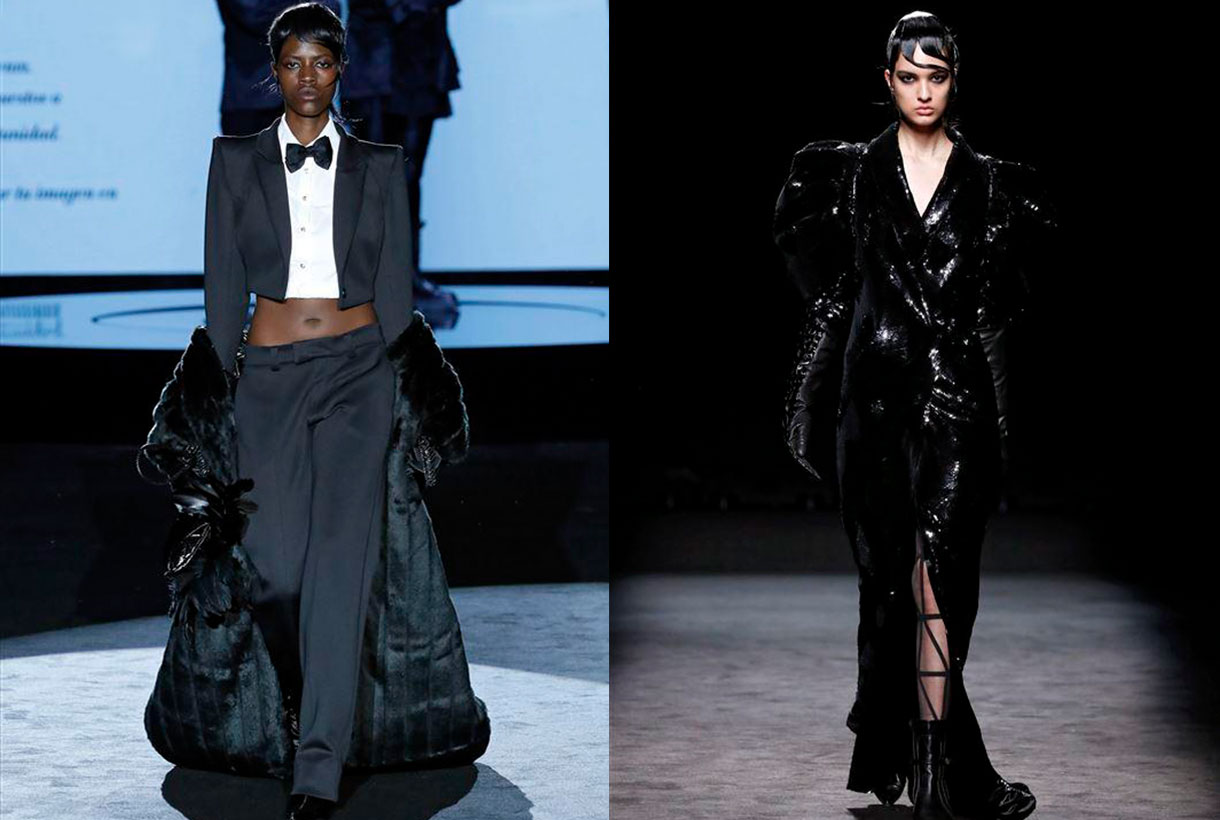
Malne
“Fashion is the glare of a moment, and it is also the immortality of beauty. Fashion is as ephemeral as unforgettable. ” Under this premise was framed the new Splendor creation from the Malne designers Paloma Álvarez and Juanjo Mánez. On the catwalk this winter collection is evident in the fusion of fabrics in the same garment or in the composition of each look, volumes in key garments with details ranging from pearls to feathers and the black and white binomial to represent the mystery and the brightness of fashion. For the feminine wardrobe it is an elegant and timeless creation for all those special occasions.

Redondo Brand
Jorge Redondo, creative director of Redondo Brand, gives a contemporary twist to party styles by reinterpreting the classics of elegance. The designer remembers his childhood when he admired the spectacular dresses that were exhibited on the red carpets and how one of his dreams would be to dress the celluloid stars. That glamour is behind a company that defines itself as “a very democratic guest brand” because it adapts the main trends on the catwalk to those of a real woman. In his new creation the eclecticism of americana becomes the central axis of the winter collection, an inspiration that merges with the essence of Redondo Brand to create natural volumes, asymmetric silhouettes and colour blends. Natural fibres such as silk, cotton or wool appear in different finishes and together with embroidered, glass or shiny pieces coexist between the more acidic and the most harmonizing tones. For the designer Jorge Redondo this sophisticated creation led to the L’Oréal Award for the best collection of the MBFWM at its 75th edition.
On the trail of… Becomely
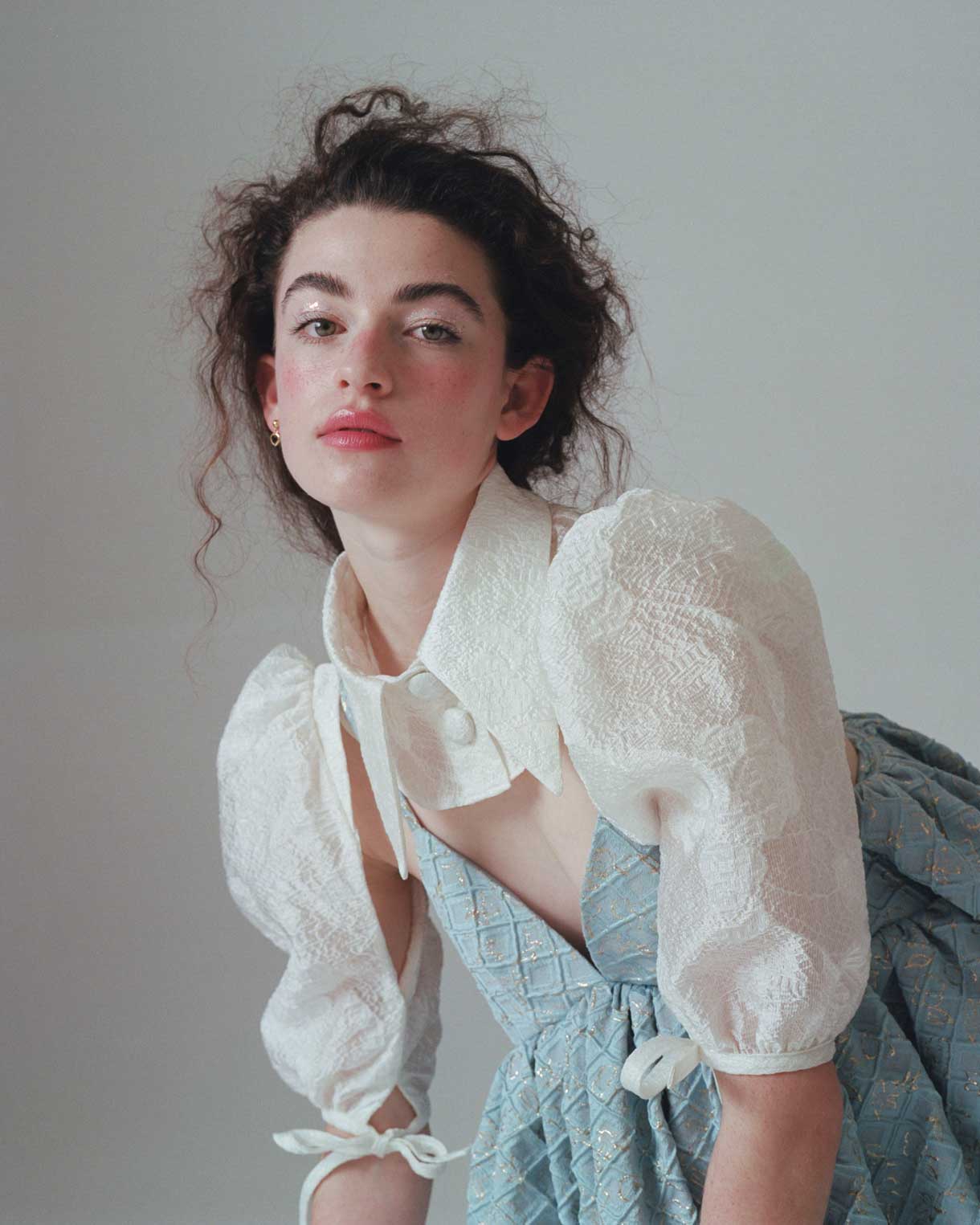
We have been following their path for a long time and have admired the creations of Quique Vidal (Valencia, 1996), alma mater of Becomely, a fashion brand with its own personality. If you follow us on Instagram, you will have seen in our feed, those baby doll silhouette dresses in pastel tones and large volumes that we usually share from the young 26-year-old creator. Despite the naive spirit, Quique Vidal’s project has nothing to do with lightness or immaturity. Quite the opposite…
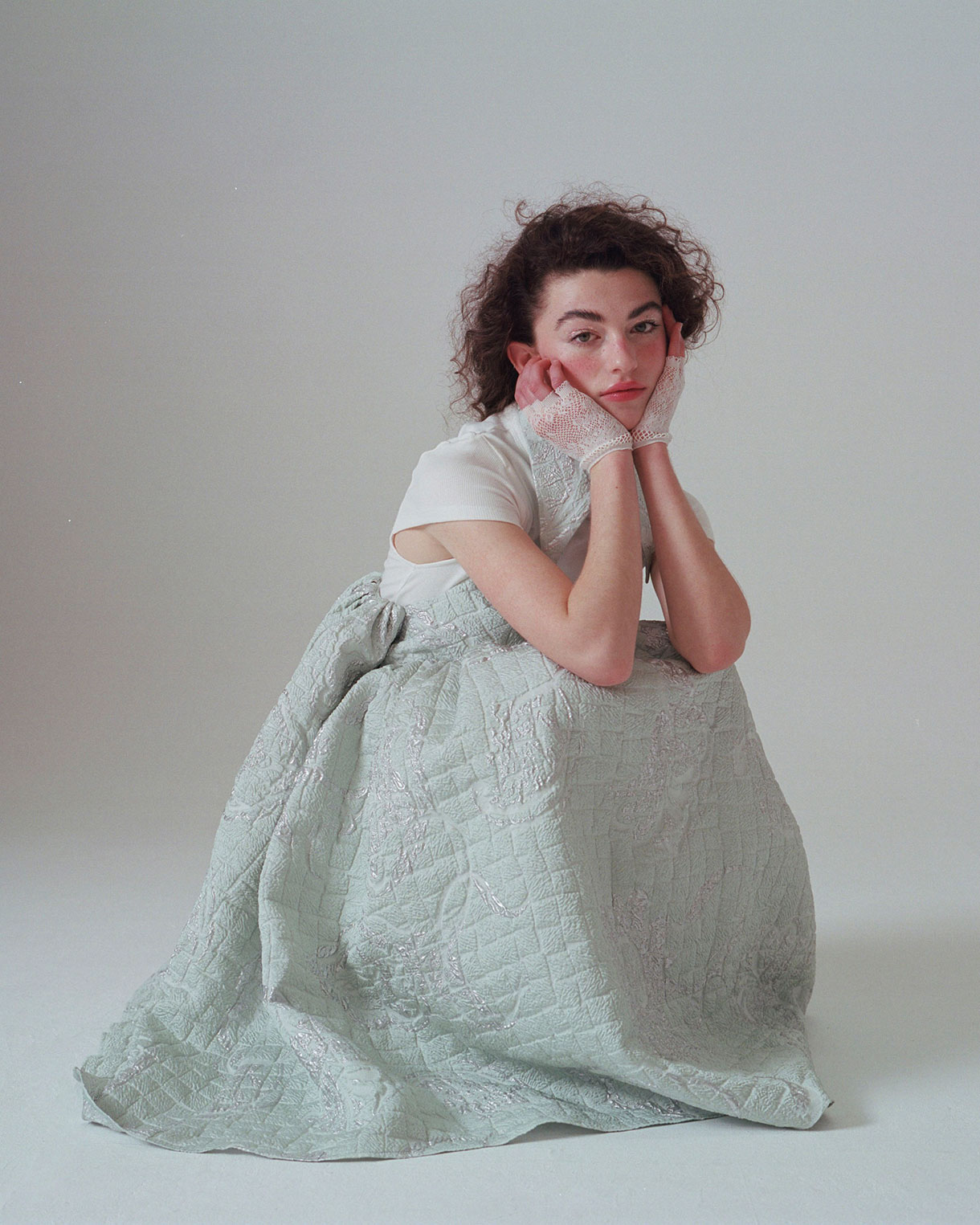
Beginnings are not easy
Becomely was officially founded in 2015. Previously, the young designer had done some work for several teachers who requested dresses for their graduation. That spontaneous start dressing anonymous women encouraged him to move to Madrid to make a living as a designer. He participated twice in Samsung EGO, the catwalk for emerging talents at MBFW Madrid. In parallel, Quique Vidal sold t-shirts, socks and also his famous biodegradable plastic costume jewelery made with 3D printing to cover part of the costs of producing and designing the collections presented. In fact, the designer currently combines his artistic work at Becomely with his other project, Estudio Cartulina, a company specializing in communication, brand consulting and production. The moonlighting artist is a reality for many young people in the world of fashion.
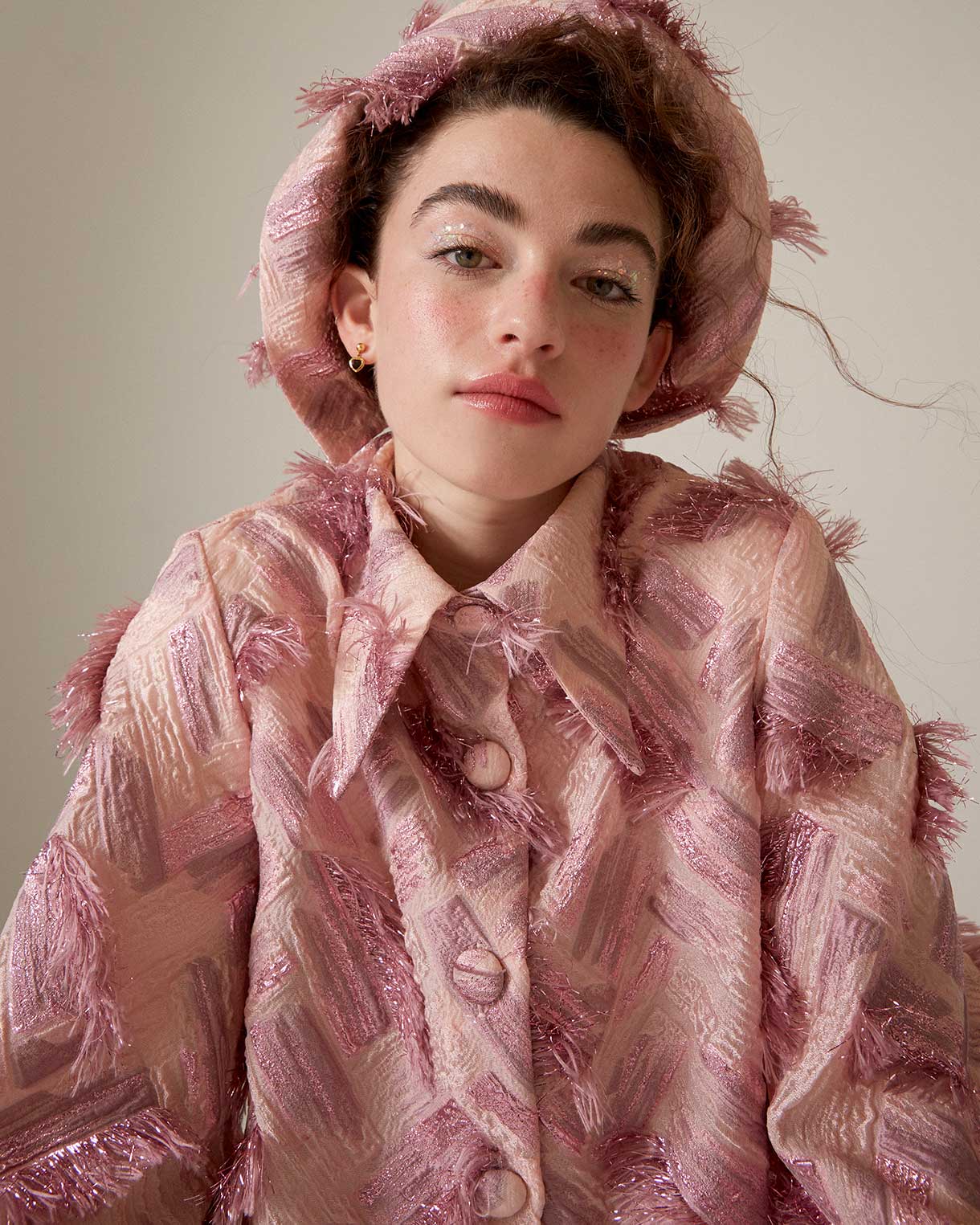
Craft and production on demand
Becomely is a sustainable, artisanal brand that creates intricate limited edition pieces that are produced on demand. The pandemic disrupted Quique’s business model to evolve towards new, more direct channels for consumers. If before they sold through the website and in some selected stores that included countries like Asia, now the Spanish firm focuses sales on social networks, especially on Instagram. This change allows greater contact with the clientele: a more personalized service can be offered and the budget can also be adjusted.
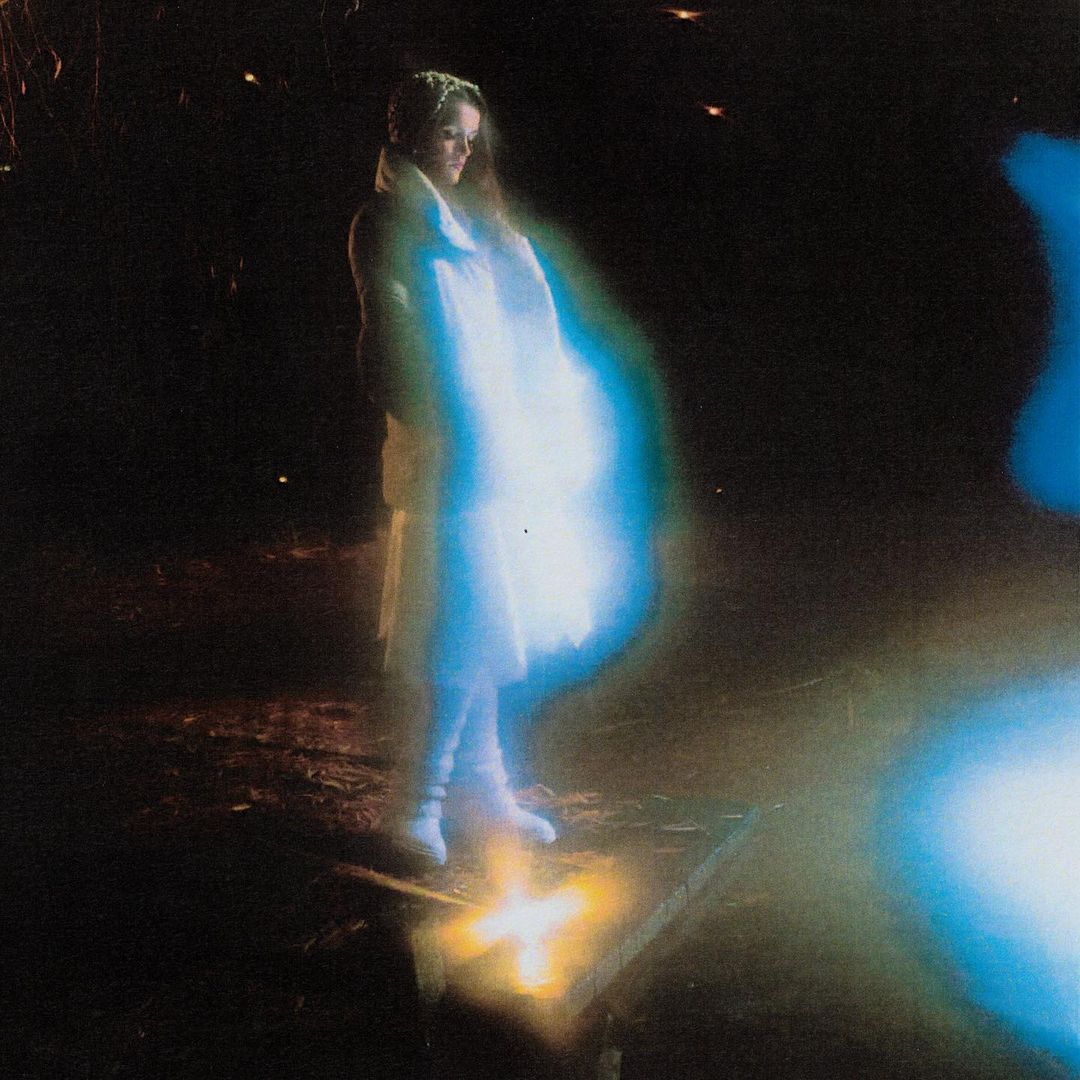
The design has not changed. Becomely maintains the emblem of the baby doll dresses with a V-neckline, puffed sleeves and volumes also in the skirt. A model that is repeated from the first collections and in which Quique Vidal is adding variations: large buttons, shirt lapels, different lengths… The fabric he uses to create his designs is also a differentiating element. Opt for eye-catching items: enigmatic Jacquards, tactile reliefs, details such as feathers, shiny motifs, fabrics with extra volume… always in pastel shades such as pale pink, baby blue, lavender or off-white. In fact, it is no mystery that Quique Vidal manages to magnify some of our most special fabrics each season. Becomely also takes advantage of the small scraps left over from his shirts and dresses to create new pieces such as bags, satchels or hats. A formula that take sustainability to its ultimate consequences.
Becomely’s designs have already hit the stage through artists like Amaia . The singer appeared in her latest video clip, Yamaguchi, wearing a white dress that follows the recognizable aesthetics of the brand and is made as we pointed out, with deadstock fabric : leftovers from suppliers or workshops. The actress Emma Suárez also noticed Quique Vidal’s creations and ordered a dress for a premiere that she had at the beginning of the year.
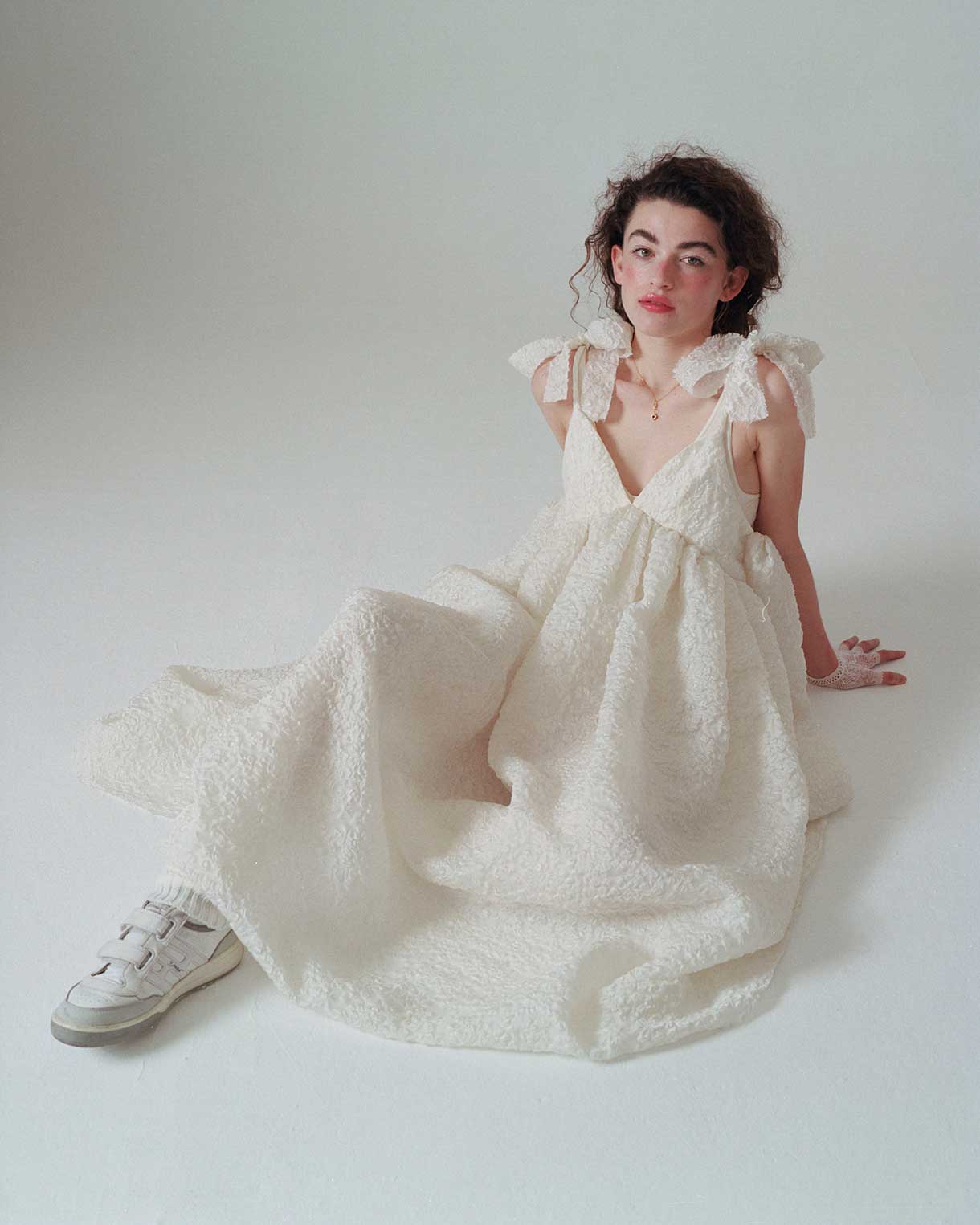
The Bride Becomely
Recently, Quique Vidal has dared to design a wedding dress that maintains the aesthetic codes of the brand. It is a flattering model that combines a minimalist silhouette with romantic elements and precious details. The dress is long with a V-neckline and straps dominated by huge bows. A voluminous skirt in embossed Jacquard fabric has just structured the ideal bridal design for millennial or Zeta brides . In fact, it is such a versatile model that it can be worn for a wedding, a special occasion or to add fantasy to a daily look, always depending on the footwear that is combined. What is clear is that there are fewer and fewer limits and barriers between formal or informal styles. Let each one interpret it in their own way!
